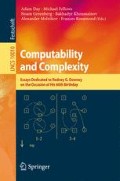Abstract
We investigate which reals can never be L-random. That is to give a description of the reals which are always belong to some \(L[\lambda ]\)-null set for any continuous measure \(\lambda \). Among other things, we prove that \(NCR_L\) is an L-cofinal subset of \(Q_3\) under \(ZFC+PD\).
Yu was partially supported by National Natural Science Fund of China grant 11322112 and Humboldt foundation. Both authors thank Professor Ambos-Spies from Heidelberg University and Professor Schindler from University of Münster for their hospitality.
Access this chapter
Tax calculation will be finalised at checkout
Purchases are for personal use only
Notes
- 1.
The function j was introduced in [14]. We use \(\kappa \) to denote \(\aleph _1\) in V to avoid any confusion.
- 2.
This is slightly different from [20, Definition 6.11]. In our situation, b needs not be wellfounded.
- 3.
i.e. \(E_{\alpha }^{\mathcal {T}}\) might be empty, in which case we do nothing and put \(\mathcal {M}_{\alpha +1}^{\mathcal {T}} = \mathcal {M}_{\alpha }^{\mathcal {T}}\), and similarly for \(\mathcal {U}\).
References
Bartoszyński, T., Judah, H.: Set Theory: On the Structure of the Real Line. A K Peters Ltd., Wellesley, MA (1995)
Chong, C.T., Liang, Y.: Recursion Theory: Computational Aspects of Definability. De Gruyter Series in Logic and Its Applications, vol. 8. De Gruyter, Berlin (2015). With an interview with Gerald E, Sacks
Downey, R.G., Hirschfeldt, D.R.: Algorithmic Randomness and Complexity. Theory and Applications of Computability. Springer, New York (2010)
Friedman, S.D.: Fine Structure and Class Forcing. De Gruyter Series in Logic and Its Applications. De Gruyter (2000)
Jech, T.: Set Theory. Springer Monographs in Mathematics. Springer, Berlin (2003)
Jensen, R., Steel, J.: \(K\) without the measurable. J. Symbolic Logic 78(3), 708–734 (2013)
Kechris, A.S.: The theory of countable analytical sets. Trans. Amer. Math. Soc. 202, 259–297 (1975)
Kechris, A.S., Martin, D.A., Solovay, R.M.: Introduction to \(Q\)-theory. In: Kechris, A.S., Martin, D.A., Moschovakis, Y.N. (eds.) Cabal Seminar 79–81. Lecture Notes in Mathematics, vol. 1019, pp. 199–282. Springer, Berlin (1983)
Kučera, A., Nies, A., Porter, C.P.: Demuth’s path to randomness. Bull. Symb. Log. 21(3), 270–305 (2015)
Moschovakis, Y.N.: Descriptive Set Theory. Mathematical Surveys and Monographs, vol. 155, 2nd edn. American Mathematical Society, Providence, RI (2009)
Reimann, J., Slaman, T.A.: Measures and their random reals. Trans. Amer. Math. Soc. 367(7), 5081–5097 (2015)
Reimann, J., Slaman, T.A.: Randomness for continuous measures (2016)
Schimmerling, E., Steel, J.R.: The maximality of the core model. Trans. Amer. Math. Soc. 351(8), 3119–3141 (1999)
Simpson, S.G.: Minimal covers and hyperdegrees. Trans. Amer. Math. Soc. 209, 45–64 (1975)
Soare, R.I.: Recursively Enumerable Sets and Degrees. Springer, Berlin (1987)
Solovay, R.M.: A model of set-theory in which every set of reals is Lebesgue measurable. Ann. of Math. (2) 92, 1–56 (1970)
Steel, J.R.: Inner models with many Woodin cardinals. Ann. Pure Appl. Logic 65(2), 185–209 (1993)
Steel, J.R.: Projectively well-ordered inner models. Ann. Pure Appl. Logic 74(1), 77–104 (1995)
Steel, J.R.: The Core Model Iterability Problem. Lecture Notes in Logic, vol. 8. Springer, Berlin (1996)
Steel, J.R.: An outline of inner model theory. In: Handbook of Set Theory. vols. 1, 2, 3, pp. 1595–1684. Springer, Dordrecht (2010)
Author information
Authors and Affiliations
Corresponding author
Editor information
Editors and Affiliations
Rights and permissions
Copyright information
© 2017 Springer International Publishing AG
About this chapter
Cite this chapter
Yu, L., Zhu, Y. (2017). On the Reals Which Cannot Be Random. In: Day, A., Fellows, M., Greenberg, N., Khoussainov, B., Melnikov, A., Rosamond, F. (eds) Computability and Complexity. Lecture Notes in Computer Science(), vol 10010. Springer, Cham. https://doi.org/10.1007/978-3-319-50062-1_36
Download citation
DOI: https://doi.org/10.1007/978-3-319-50062-1_36
Published:
Publisher Name: Springer, Cham
Print ISBN: 978-3-319-50061-4
Online ISBN: 978-3-319-50062-1
eBook Packages: Computer ScienceComputer Science (R0)

